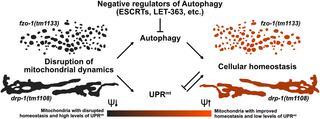PLOS Genetics ( IF 4.5 ) Pub Date : 2020-03-19 , DOI: 10.1371/journal.pgen.1008638 Simon Haeussler 1 , Fabian Köhler 1 , Michael Witting 2, 3 , Madeleine F Premm 1 , Stéphane G Rolland 1 , Christian Fischer 1, 4 , Laetitia Chauve 5 , Olivia Casanueva 5 , Barbara Conradt 1, 4, 6

|
Compromising mitochondrial fusion or fission disrupts cellular homeostasis; however, the underlying mechanism(s) are not fully understood. The loss of C. elegans fzo-1MFN results in mitochondrial fragmentation, decreased mitochondrial membrane potential and the induction of the mitochondrial unfolded protein response (UPRmt). We performed a genome-wide RNAi screen for genes that when knocked-down suppress fzo-1MFN(lf)-induced UPRmt. Of the 299 genes identified, 143 encode negative regulators of autophagy, many of which have previously not been implicated in this cellular quality control mechanism. We present evidence that increased autophagic flux suppresses fzo-1MFN(lf)-induced UPRmt by increasing mitochondrial membrane potential rather than restoring mitochondrial morphology. Furthermore, we demonstrate that increased autophagic flux also suppresses UPRmt induction in response to a block in mitochondrial fission, but not in response to the loss of spg-7AFG3L2, which encodes a mitochondrial metalloprotease. Finally, we found that blocking mitochondrial fusion or fission leads to increased levels of certain types of triacylglycerols and that this is at least partially reverted by the induction of autophagy. We propose that the breakdown of these triacylglycerols through autophagy leads to elevated metabolic activity, thereby increasing mitochondrial membrane potential and restoring mitochondrial and cellular homeostasis.
中文翻译:

自噬可补偿线粒体动力学中的缺陷。
破坏线粒体融合或裂变会破坏细胞稳态。但是,尚未完全理解其基本机制。C的损失。线虫fzo-1 MFN导致线粒体断裂,线粒体膜电位降低和线粒体折叠蛋白应答(UPR mt)的诱导。我们进行了全基因组的RNAi筛选,筛选出敲低fzo-1 MFN(lf)诱导的UPR mt的基因。在鉴定出的299个基因中,有143个编码自噬的负调控因子,其中许多以前并未参与这种细胞质量控制机制。我们提供证据表明自噬通量增加会抑制fzo-1MFN(lf)通过增加线粒体膜电位而不是恢复线粒体形态来诱导UPR mt。此外,我们证明增加的自噬通量还抑制了UPR mt的诱导,以响应线粒体裂变的阻滞,而不是响应于spg -7 AFG3L2的丧失,它编码线粒体金属蛋白酶。最后,我们发现阻断线粒体融合或裂变会导致某些类型的三酰基甘油水平升高,并且这至少部分通过自噬的诱导得以恢复。我们建议通过自噬这些三酰基甘油的分解导致升高的代谢活性,从而增加线粒体膜电位并恢复线粒体和细胞体内平衡。



























 京公网安备 11010802027423号
京公网安备 11010802027423号